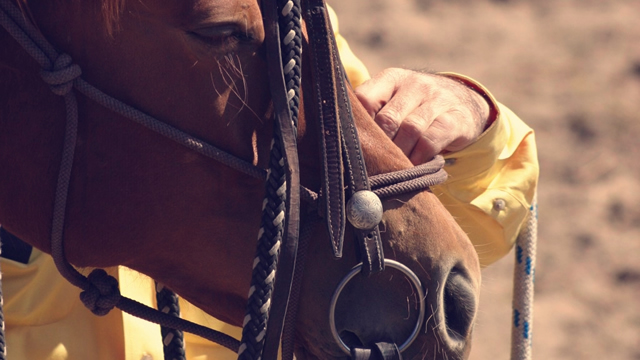Written by Martin Black
This article originally appeared in Eclectic Horseman Issue No.68
What makes some horses bad to bridle and some are eager to take it? There are lots of reasons to be bad. Some horses may have one reason; others may have several reasons. The horses that are good have obviously had better experiences or are very tolerant. All of them would need to learn a certain level of tolerance to accept a foreign object in their mouth or on their head.
Witnessing a bridling problem reminds me of my mother when we were kids. As we were walking in the church yard, she would lick her thumb and grab us to wash smudges off our face. I’m not sure which was worse, the wet thumb or the trapped feeling knowing something bad was going to happen. Either way it was always a fight.
If we can closely observe the process of a person bridling a horse and try to consider the horse’s perspective of every detail taking place, many of the things that are triggering the horse’s rejection are going unnoticed by the person focused on getting the bit in the mouth then the headstall over the ears.
As we begin the bridling process, the bit is hurried to the lips before they can move and get away. The whiskers might get snagged and pulled on, causing the horse discomfort. In some cases, horses may have had their whiskers shaved to prevent this, although they would prefer to keep them since they are part of their sensory system. As we get past the whiskers, then the lips might get pinched between the bit and the teeth. Anywhere in the process, when the horse tries to move to a more comfortable position the person generally tries to “hurry and get them before they get away.”
Next we have 12 incisors, 8 of them shedding and new permanent teeth coming in between 2 and 4 years old, while most horses are being ridden. They come in sets of 4 each year, and they don’t all just fall out one day when we aren’t riding them. Each one could take several days to a couple weeks to loosen and then fall out and, like children, the process can be painful and annoying, just getting through one experience only to start the next.
https://eclectic-horseman.com/mercantile/horse-training-dvds/fundamental-horse-training/bridle-horse-series-with-martin-black/
Once a horse can get the bit on their tongue and pick it up and hold it, we go on to put the headstall over their head. But that isn’t always as simple for the horse as it may sound. Many brow band headstalls, as we are positioning the bit close to the mouth, will be gouging them in the eye, and then as we pull it against and past the eye, those whiskers can also be pulled, which may cause the horse to pull away or shake their head.
Now all that is left is to pull some mane hair and pinch the ears while we are putting the headstall in place. Does this make you think about how your horse accepts you bridling them? It is supposed to. The biggest difference between developing a horse that is good to bridle or hard to bridle is how considerate and how big a hurry we are in when we bridle them. One extra minute on most horses would make a lot of difference.
As you go through the process, notice when the horse tries to avoid a step and consider the possibility of what you did now or in the past that may have caused the problem.
Just as important as the bridling process is how they are unbridled. We need to be just as considerate and patient unbridling as we are bridling. After all, the last impression we make on a horse will be the first impression they have the next time we revisit any situation. Most any horse given the opportunity to take a bridle without any discomfort can take it willingly without any resistance.
This article originally appeared in Eclectic Horseman Issue No.68


